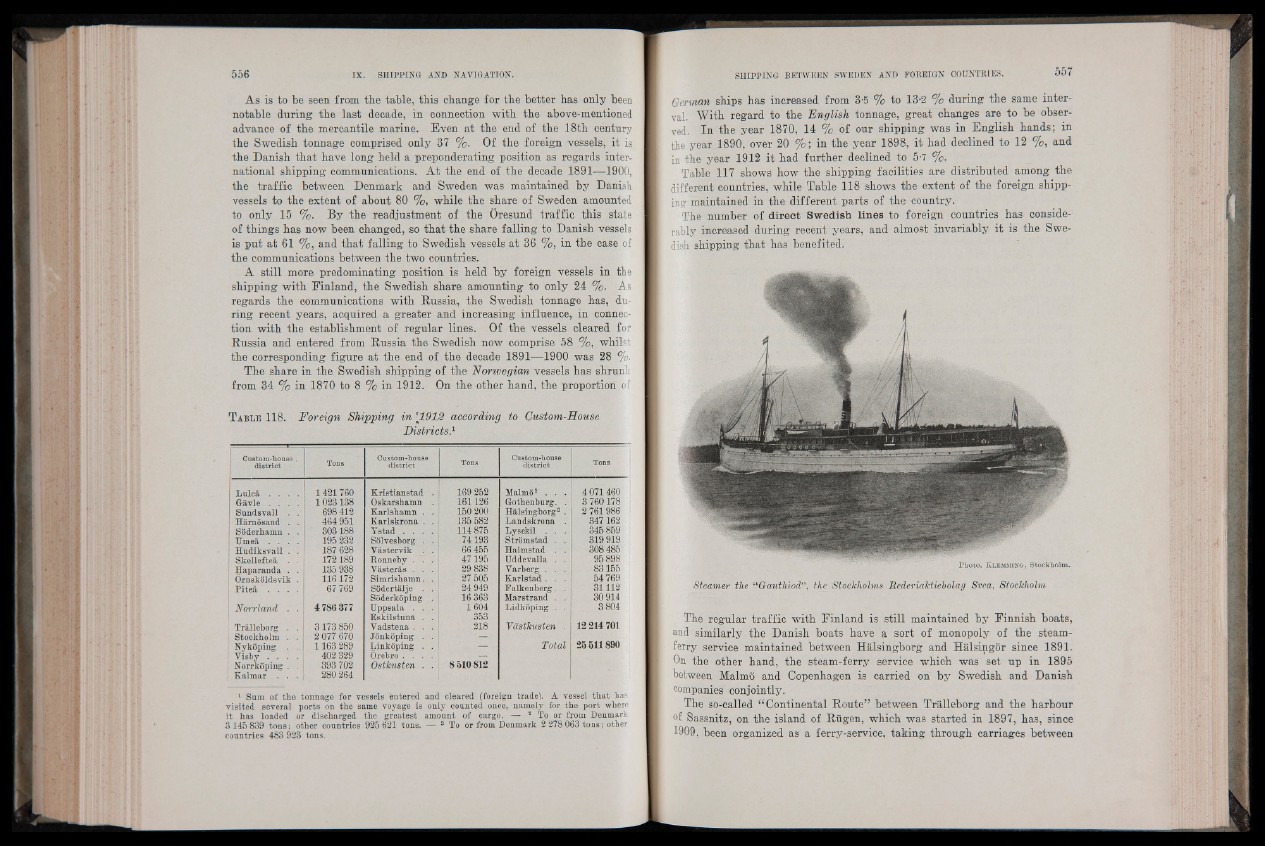
As is to be seen from the table, this change for the better has only been
notable during the last decade, in connection with the above-mentioned
advance of the mercantile marine. Even at the end of the 18th century
the Swedish tonnage comprised only 37 %. Of the foreign vessels, it is
the Danish that have long held a preponderating position as regards international
shipping communications. At the end of the decade 1891—1900,
the traffic between Denmark and Sweden was maintained by Danish
vessels to the extent of about 80 %, while the share of Sweden amounted
to only 15 %. By the readjustment of the Oresund traffic this state
of things has now been changed, so that the share falling to Danish vessels
is put at 61 %, and that falling to Swedish vessels at 36 %, in the case of
the communications between the two countries.
A still more predominating position is held by foreign vessels in the
shipping with Finland, the Swedish share amounting to only 24 %. As
regards the communications with Russia, the Swedish tonnage has, during
recent years, acquired a greater and increasing influence, in connection
with the establishment of regular lines. Of the vessels cleared for
Russia and entered from Russia the Swedish now comprise 58 %, whilst
the corresponding figure at the end of the decade 1891-111900 was 28 '%.
The share in the Swedish shipping of the 'Norwegian vessels has shrunk
from 34 % in 1870 to 8 % in 1912. On the other hand, the proportion of
T a b l e 118. Foreign Shipping in [1912 according to Custom-House
Districts.1
Custom-house .
d is tr ic t Tons
Custom-house
d is tr ic t Tons
Custom-house
d is tr ic t Tons
Luleâ . . . . 1421760 Kristianstad . 169 252 Malmö2 . . . 4071 460
Grävle . . . . 1023138 Oskarshamn . 161126 Gothenburg. . 3 760178
Sundsvall . . 698412 Karlshamn . . 150 200 Hälsingborg3 . 2 761986
Härnösand . . 464 951 Karlskrona . . v 135 582 Landskrona . 347162
Söderhamn . . 303188 Ystad . . . . 114 875 Lysekil . . . 345859
Umeâ . . . . 195 232 Sölvesborg . . 74193 Strömstad . . 319 919
Hudiksvall . . 187 628 Västervik . . 66 455 Haimstad . . 308 485
Skellefteâ . . 172189 Ronneby . . . 47195 Uddevalla . . 95898
Haparanda . . 135 938 Västeräs . . . 29 838 Varberg . . . 83155
Örnsköldsvik . 116172 Simrishamn. . 27 505 Karlstad . . . 54 769
Piteâ . . . . 67 769 Södertälje . . 24 949 Falkenberg. . 31112
Söderköping . 16 363 Marstrand . . 30 914
Norrland . . 4 786 377 Uppsala . . . 1604 Lidköping . . 3 804
Eskilstuna . . 353
Trälleborg . . 3173 850 Vadstena . . . 218 Västkusten . 12214 701
Stockholm . . 2 077 670 Jönköping . . ■ — ..
Nyköping . . 1163 289 Linköping . . — Total 25511890
Visby . . . . 402 329 Örebro . . . .
Norrköping . . 393 702 Ostkusten . . 8510812
Kalmar . . . 280 264
1 Sam of the tonnage for vessels entered and cleared (foreign trade). A vessel th a t has
visited several ports on the same voyage is only connted once, namely for the port where
it has loaded or discharged the greatest amount of cargo. —• 2 To or from Denmark
3 145 839 tons; other countries 925 621 tons. — 3 To or from Denmark 2 278 063 tons; other
countries 483 923 tons.
German ships has increased from 3-5 % to 13-2 % during the same interval.
With regard to the English tonnage, great changes are to be observed.
In the year 1870, 14 % of our shipping was in English hands; in
the year 1890, over 20 %; in the year 1898, it had declined to 12 %, and
in the year 1912 it had further declined to 5-7 %.
Table 117 shows how the shipping facilities are distributed among the
different countries, while Table 118 shows the extent of the foreign shipping
maintained in the different parts of the country.
The number of direct Swedish, lines to foreign countries has considerably
increased during recent years, and almost invariably it is the Swedish
shipping that has benefited.
P h o to . Iv lemming, S to c k h o lm .
Steamer the “Gauthiod”, the Stockholms Rederiaktiebolag Svea, Stockholm
The regular traffic with Finland is still maintained by Finnish boats,
and similarly the Danish boats have a sort of monopoly of the steam-
ferry service maintained between Hälsingborg and Hälsingör since 1891.
On the other hand, the steam-ferry service which was set up in 1895
between Malmö and Copenhagen is carried on by Swedish and Danish
companies conjointly.
The so-called “Continental Route” between Trälleborg and the harbour
°f Sassnitz, on the island of Rügen, which was started in 1897, has, since
1909, been organized as a ferry-service, taking through carriages between